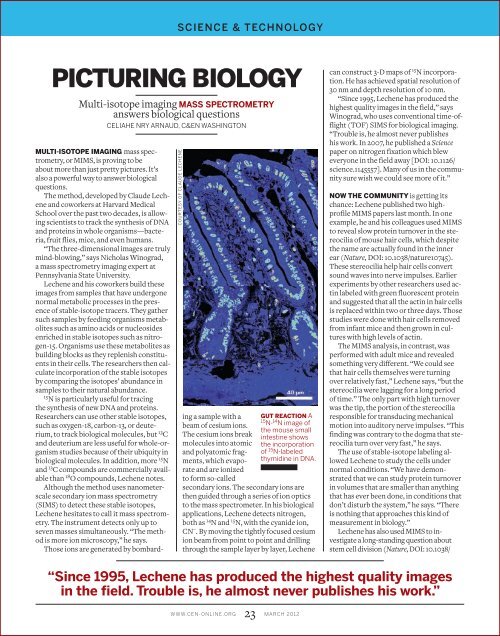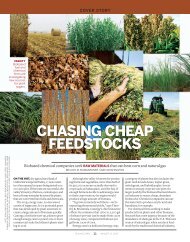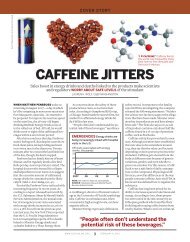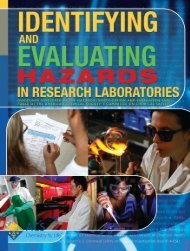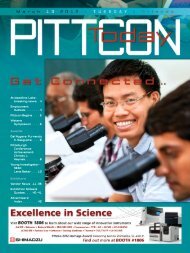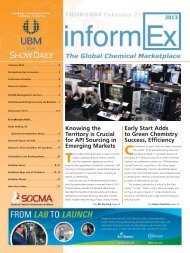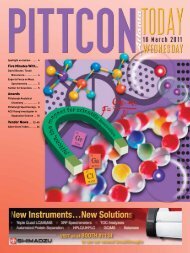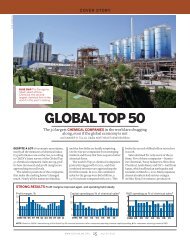focus on life sciences - Chemical & Engineering News - American ...
focus on life sciences - Chemical & Engineering News - American ...
focus on life sciences - Chemical & Engineering News - American ...
- No tags were found...
You also want an ePaper? Increase the reach of your titles
YUMPU automatically turns print PDFs into web optimized ePapers that Google loves.
SCIENCE & TECHNOLOGYPICTURING BIOLOGYMulti-isotope imaging MASS SPECTROMETRYanswers biological questi<strong>on</strong>sCELIA HE NRY ARNAUD , C&EN WASHINGTONCOURTESY OF CLAUDE LECHENEMULTI-ISOTOPE IMAGING mass spectrometry,or MIMS, is proving to beabout more than just pretty pictures. It’salso a powerful way to answer biologicalquesti<strong>on</strong>s.The method, developed by Claude Lecheneand coworkers at Harvard MedicalSchool over the past two decades, is allowingscientists to track the synthesis of DNAand proteins in whole organisms—bacteria,fruit flies, mice, and even humans.“The three-dimensi<strong>on</strong>al images are trulymind-blowing,” says Nicholas Winograd ,a mass spectrometry imaging expert atPennsylvania State University.Lechene and his coworkers build theseimages from samples that have underg<strong>on</strong>enormal metabolic processes in the presenceof stable-isotope tracers. They gathersuch samples by feeding organisms metabolitessuch as amino acids or nucleosidesenriched in stable isotopes such as nitrogen-15.Organisms use these metabolites asbuilding blocks as they replenish c<strong>on</strong>stituentsin their cells. The researchers then calculateincorporati<strong>on</strong> of the stable isotopesby comparing the isotopes’ abundance insamples to their natural abundance.15N is particularly useful for tracingthe synthesis of new DNA and proteins.Researchers can use other stable isotopes,such as oxygen-18, carb<strong>on</strong>-13, or deuterium,to track biological molecules, but 13 Cand deuterium are less useful for whole-organismstudies because of their ubiquity inbiological molecules. In additi<strong>on</strong>, more 15 Nand 13 C compounds are commercially availablethan 18 O compounds, Lechene notes.Although the method uses nanometerscalesec<strong>on</strong>dary i<strong>on</strong> mass spectrometry(SIMS) to detect these stable isotopes,Lechene hesitates to call it mass spectrometry.The instrument detects <strong>on</strong>ly up toseven masses simultaneously. “The methodis more i<strong>on</strong> microscopy,” he says.Those i<strong>on</strong>s are generated by bombardinga sample with abeam of cesium i<strong>on</strong>s.The cesium i<strong>on</strong>s breakmolecules into atomicand polyatomic fragments,which evaporateand are i<strong>on</strong>izedto form so-calledGUT REACTION A15N- 14 N image ofthe mouse smallintestine showsthe incorporati<strong>on</strong>of 15 N-labeledthymidine in DNA.sec<strong>on</strong>dary i<strong>on</strong>s. The sec<strong>on</strong>dary i<strong>on</strong>s arethen guided through a series of i<strong>on</strong> opticsto the mass spectrometer. In his biologicalapplicati<strong>on</strong>s, Lechene detects nitrogen,both as 14 N and 15 N, with the cyanide i<strong>on</strong>,CN – . By moving the tightly <str<strong>on</strong>g>focus</str<strong>on</strong>g>ed cesiumi<strong>on</strong> beam from point to point and drillingthrough the sample layer by layer, Lechenecan c<strong>on</strong>struct 3-D maps of 15 N incorporati<strong>on</strong>.He has achieved spatial resoluti<strong>on</strong> of30 nm and depth resoluti<strong>on</strong> of 10 nm.“Since 1995, Lechene has produced thehighest quality images in the field,” saysWinograd, who uses c<strong>on</strong>venti<strong>on</strong>al time-offlight(TOF) SIMS for biological imaging.“Trouble is, he almost never publisheshis work. In 2007, he published a Sciencepaper <strong>on</strong> nitrogen fixati<strong>on</strong> which blewevery<strong>on</strong>e in the field away [DOI: 10.1126/science.1145557 ]. Many of us in the communitysure wish we could see more of it.”NOW THE COMMUNITY is getting itschance: Lechene published two highprofileMIMS papers last m<strong>on</strong>th. In <strong>on</strong>eexample, he and his colleagues used MIMSto reveal slow protein turnover in the stereociliaof mouse hair cells, which despitethe name are actually found in the innerear ( Nature, DOI: 10.1038/nature10745 ).These stereocilia help hair cells c<strong>on</strong>vertsound waves into nerve impulses. Earlierexperiments by other researchers used actinlabeled with green fluorescent proteinand suggested that all the actin in hair cellsis replaced within two or three days. Thosestudies were d<strong>on</strong>e with hair cells removedfrom infant mice and then grown in cultureswith high levels of actin.The MIMS analysis, in c<strong>on</strong>trast, wasperformed with adult mice and revealedsomething very different. “We could seethat hair cells themselves were turningover relatively fast,” Lechene says, “but thestereocilia were lagging for a l<strong>on</strong>g periodof time.” The <strong>on</strong>ly part with high turnoverwas the tip, the porti<strong>on</strong> of the stereociliaresp<strong>on</strong>sible for transducing mechanicalmoti<strong>on</strong> into auditory nerve impulses. “Thisfinding was c<strong>on</strong>trary to the dogma that stereociliaturn over very fast,” he says.The use of stable-isotope labeling allowedLechene to study the cells undernormal c<strong>on</strong>diti<strong>on</strong>s. “We have dem<strong>on</strong>stratedthat we can study protein turnoverin volumes that are smaller than anythingthat has ever been d<strong>on</strong>e, in c<strong>on</strong>diti<strong>on</strong>s thatd<strong>on</strong>’t disturb the system,” he says. “Thereis nothing that approaches this kind ofmeasurement in biology.”Lechene has also used MIMS to investigatea l<strong>on</strong>g-standing questi<strong>on</strong> aboutstem cell divisi<strong>on</strong> ( Nature, DOI: 10.1038/“Since 1995, Lechene has produced the highest quality imagesin the field. Trouble is, he almost never publishes his work.”WWW.CEN-ONLINE.ORG 23 MARCH 2012


